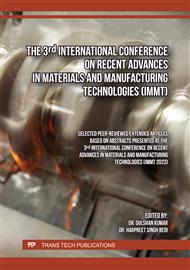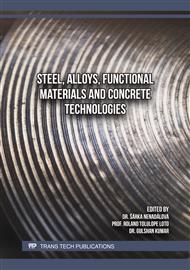p.3
p.15
p.27
p.43
p.53
p.59
p.67
p.77
p.85
Mössbauer Spectroscopy Analysis of FeCo Nano-Particles Alloy Synthesized by Hydrothermal Method
Abstract:
Mössbauer spectroscopy (MS), was used to characterize the synthesized materials prepared from the elemental powders by hydrothermal method which are binary iron-based nanoparticles (NPs) Fe15Co85 and Fe10Co90 alloys. The transmission 57Fe Mössbauer spectra were measured at room temperature RT (T~300K), using 57Co γ-ray source with an Activity ~ 1.85 GBq (50 mCi). The analysis of Mössbauer spectra curves was by using WinNormos with two subspectra with the “Site” option and then with the “Dist” option in order to learn more about hyperfine interactions and parameters such as isomer shifts IS, quadruple splitting QS and hyperfine magnetic field Bhf. MS results observe only one Zeeman sextet with a relative area of ~77.125% with parameter Bhf = 32.727 T and line width Γ=0.693 mm/s for Fe10Co90, and a relative area of ~84.719% with parameter Bhf = 34.354 T and line width Γ=1.043 mm/s for Fe15Co85 and one broad singlet which confirms the body-centered cubic structure BCC. The main contribution to the spectra comes from the magnetic sextet which is assigned to ferromagnetic FeCo phase which is the dominant one while the singlet is assigned to paramagnetic phase. As a result of the analysis of the distributions hyperfine magnetic field the average values of the hyperfine parameters of the Mössbauer spectra were obtained <Bhf>Fe10Co90 = 28.3363 T and <Bhf>Fe15Co85 = 31.4657 T. Therefore, it is observed that the increasing of the cobalt concentration decreases the hyperfine field. The results observe indicates Co concentration dependence, where for Co-rich alloys (Fe10Co90) the FCC (face-centered cubic structure) contributing to the decrease in Bhf due to the absence of BCC. the obtained NPs most likely to be in disordered structure A2.
Info:
Periodical:
Pages:
53-58
Citation:
Online since:
May 2025
Price:
Сopyright:
© 2025 Trans Tech Publications Ltd. All Rights Reserved
Share:
Citation:



